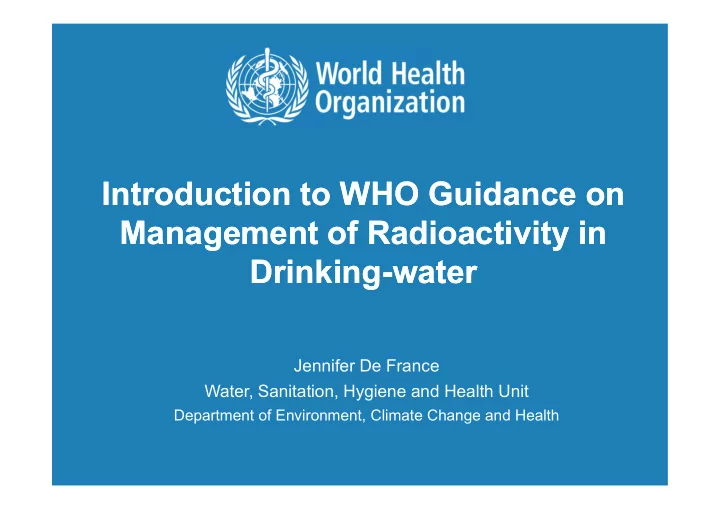

Introduction to WHO Guidance on Introduction to WHO Guidance on Management of Radioactivity in Management of Radioactivity in Drinking-water Drinking-water Jennifer De France Water, Sanitation, Hygiene and Health Unit Department of Environment, Climate Change and Health
Water quality Water quality The quality of water, whether used for drinking, domestic purposes, food production or recreational purposes, has an important impact on health 829,000 diarrhoeal deaths Coming soon! from inadequate water, sanitation and hygiene – ~60% from inadequate water – 5.3% of all deaths < 5 years ٢ |
2030 Sustainable Development Agenda 2030 Sustainable Development Agenda 17 Goals, 169 targets, 230 global indicators ٣ | 3
Goal 6: Ensure availability and sustainable Goal 6: Ensure availability and sustainable management of water and sanitation for all management of water and sanitation for all Means of 6.1 implementation Drinking water 6.2 6.a 6.6 Sanitation International Eco- and cooperation systems hygiene and capacity Goal 6 development 6.5 Water 6.3 resource Water 6.b manage quality Local ment 6.4 participation Water scarcity ٤ |
Global indicator for drinking-water Global indicator for drinking-water PRIORITY INDICATOR: 6.1.1 % of population using safely managed drinking-water services, which is: located on premises available when needed, and free of faecal and priority chemical contamination ( E. coli /thermotolerant coliforms, arsenic, fluoride) ٥ |
Global indicator for drinking-water Global indicator for drinking-water PRIORITY INDICATOR: 6.1.1 % of population using safely managed drinking-water services, which is: Accessibility located on premises Availability available when needed, and Quality free of faecal and priority chemical contamination ( E. coli /thermotolerant coliforms, arsenic, fluoride) ٦ |
A flagship normative publication of WHO A flagship normative publication of WHO WHO International Standards for Drinking- Guidelines for Drinking-water Quality, water, 1st Edition, 1958 4 th Edition, incl. Addendum, 2017 ٧ |
A flagship normative publication of WHO A flagship normative publication of WHO WHO International Standards for Drinking- Guidelines for Drinking-water Quality, water, 1st Edition, 1958 4 th Edition, incl. Addendum, 2017 “Immediate and wide recognition as essential aids to Demand for the document is among the the improvement of water highest and most sustained of all WHO quality and treatment” publications ٨ |
WHO Guidelines for Drinking-water Quality WHO Guidelines for Drinking-water Quality Aim Protection of human health –Support setting of national standards and regulations Target Audience Regulators + (water suppliers, practitioners . . .) Approach Best available evidence - science and practice Risk-benefit philosophy (advisory in nature) Evidence-based Local adaptation considering overall health protection strategies – Social, cultural, economic and environmental context Preventive incorporating multiple barriers Incremental improvement ٩ |
Core Recommendations Core Recommendations Framework for Safe Drinking-water Framework for Safe Drinking-water Establish national water quality Health-based targets standards on relevant waterborne (National regulatory body) hazards Undertake site-specific local Water Safety Plan risk assessment and (Water utility) management from catchment to consumer Verify water safety through Independent surveillance independent tests and audits (Surveillance agency) ١٠ |
١١ |
Chapter 9 of GDWQ: Radioactivity Criteria with which to assess safety of For situations where drinking-water with respect to radionuclide there could be ingestion of content radionuclides in drinking-water over Methodology to assess potential health risks extended periods of ( screening approach based on IDC of 0.1 time mSv/year ) (years – lifetime) Guidance on actions to reduce radionuclides in drinking-water and monitoring considerations Information on analytical methods Separate guidance on radon ١٢ |
Chapter 9 of GDWQ: Radioactivity Chapter 9 of GDWQ: Radioactivity Key considerations Key considerations No distinction between criteria for natural and artificial radionuclides. However, management may differ (point of control and ability to control) Natural radionuclides usually of greater concern for drinking- water When considering actions to take in assessing and managing radiological risks, care should be taken to ensure that scarce resources are not diverted away from other, more important, public health concerns ١٣ |
Experience with Implementation of the GDWQ Guidance Levels More guidance needed on what are appropriate actions if screening levels are exceeded – Should there be a water supply restriction if guidance levels are exceeded (based on IDC of 0.1 mSv/year)? – How to consider the International BSS reference level of 1 mSv/year (explicitly referenced in the GDWQ)? ١٤ |
Experience with Implementation of the GDWQ Guidance Levels More guidance needed on what are appropriate actions if screening levels are exceeded – Should there be a water supply restriction if guidance levels are exceeded (based on IDC of 0.1 mSv/year)? – How to consider the International BSS reference level of 1 mSv/year (explicitly referenced in the GDWQ)? The individual dose criterion (IDC) should not be interpreted as a limit above which drinking-water is unsafe for consumption. The International Basic Safety Standards (BSS) should not be regarded either as an “acceptable” dose or as a dose limit, and all reasonable efforts should be made to minimize the doses received. ١٥ |
Guidance Developed to Support Guidance Developed to Support Implementation of Chapter 9 of the GDWQ Implementation of Chapter 9 of the GDWQ PURPOSE Provide practical guidance to support interpretation and implementation of the GDWQ in order to take appropriate action AUDIENCE Organizations that set or enforce standards related to, or manage risks from, radioactivity in drinking-water Format Written in the style of Q&As to enable easier reading of the issues of interest ١٦ |
Content overview Content overview Chapter 1 : background information, information on management of radionuclides in non-emergency situations. Chapter 2 : information on management of radionuclides in emergency situations. Chapter 3 : supporting information common to both non- emergency and emergency situations, including information on water treatment and analytical methods. Chapter 4 : case studies Annex : information to support calculation of doses and guidance levels for specific non-emergency situations. ١٧ |
Chapter 1
Next Steps Next Steps Continue disseminating WHO guidance Address additional issues identified by GDWQ Rad WG and new evidence Update 5 th Edition of the GDWQ ١٩ |
Thank you very much! For more information visit: https://www.who.int/water_sanitation_health
Recommend
More recommend